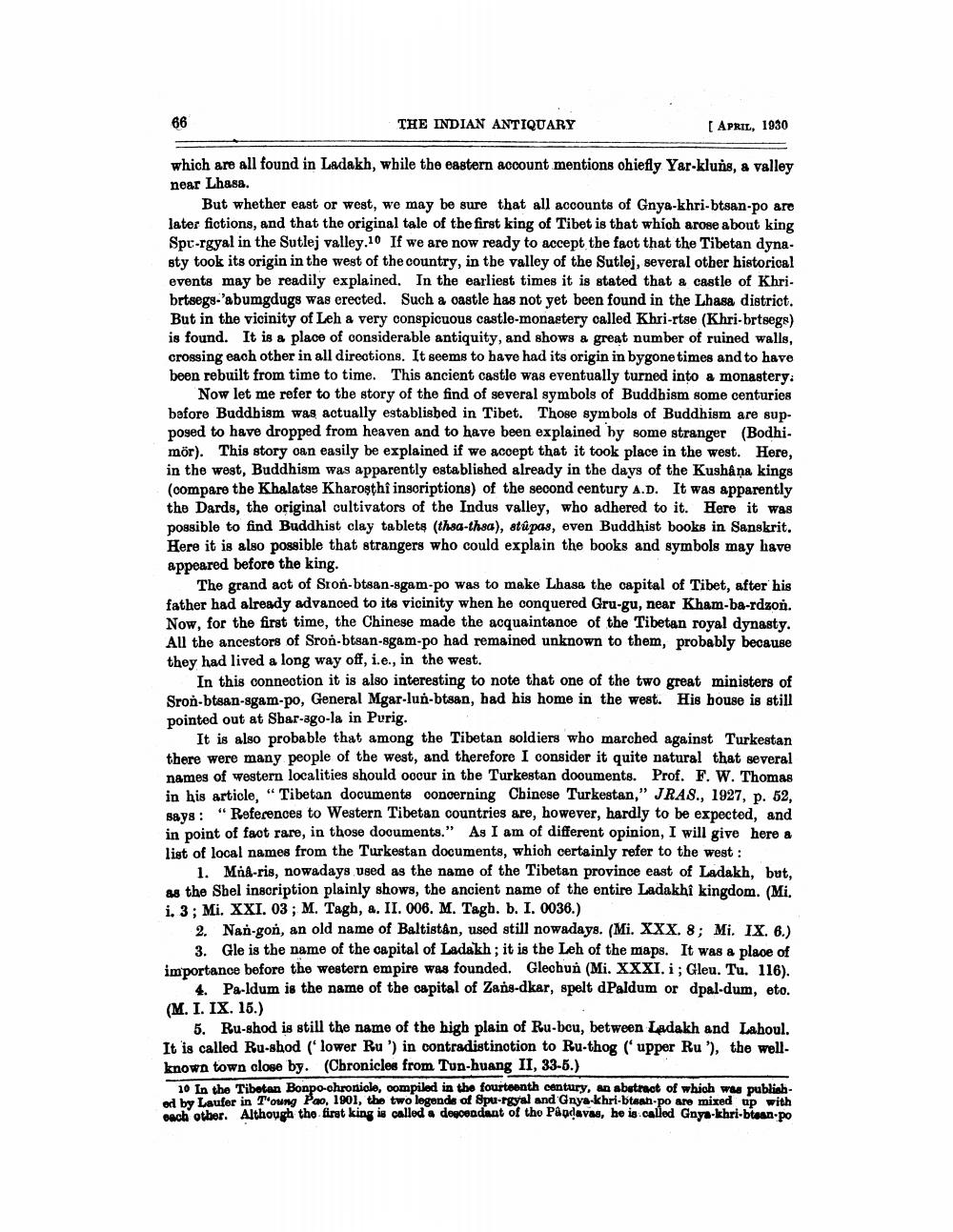________________
THE INDIAN ANTIQUARY
[APRIL, 1930
which are all found in Ladakh, while the eastern account mentions chiefly Yar-kluns, a valley near Lhasa.
But whether east or west, we may be sure that all accounts of Gnya-khri-btsan-po are later fictions, and that the original tale of the first king of Tibet is that which arose about king Spr-rgyal in the Sutlej valley.10 If we are now ready to accept the fact that the Tibetan dynasty took its origin in the west of the country, in the valley of the Sutlej, several other historical events may be readily explained. In the earliest times it is stated that & castle of Khri. brtsegg-'abumgdugs was erected. Such a castle has not yet been found in the Lhasa district. But in the vicinity of Leh a very conspicuous castle-monastery called Khri-rtse (Khri-brtsegs) is found. It is a place of considerable antiquity, and shows a great number of ruined walls, crossing each other in all directions. It seems to have had its origin in bygone times and to have been rebuilt from time to time. This ancient castle was eventually turned into a monastery.
Now let me refer to the story of the find of several symbols of Buddhism some centuries before Buddbism was actually established in Tibet. Those symbols of Buddhism are supposed to have dropped from heaven and to have been explained by some stranger (Bodhi. mör). This story oan easily be explained if we accept that it took place in the west. Here, in the west, Buddhism was apparently established already in the days of the Kushana kings (compare the Khalatee Kharoşthî inscriptions) of the second century A.D. It was apparently the Dards, the original cultivators of the Indus valley, who adhered to it. Here it was possible to find Buddhist clay tablets (thsa-thsa), stúpas, even Buddhist books in Sanskrit. Here it is also possible that strangers who could explain the books and symbols may have appeared before the king.
The grand act of Sron-btsan-sgam-po was to make Lhasa the capital of Tibet, after his father had already advanced to its vicinity when he conquered Gru-gu, near Kham-ba-rdzon. Now, for the first time, the Chinese made the acquaintance of the Tibetan royal dynasty. All the ancestors of Sron-btsan-sgam-po had remained unknown to them, probably because they had lived a long way off, i.e., in the west.
In this connection it is also interesting to note that one of the two great ministers of Sron-btsan-sgam-po, General Mgar-lun-btsan, had his home in the west. His house is still pointed out at Sbar-ago-la in Purig.
It is also probable that among the Tibetan soldiers who marched against Turkestan there were many people of the west, and therefore I consider it quite natural that several names of western localities should oocur in the Turkestan doouments. Prof. F. W. Thomas in his article, “Tibetan documents concerning Chinese Turkestan," JRAS., 1927, p. 52, says: "References to Western Tibetan countries are, however, hardly to be expected, and in point of fact rare, in those documents." As I am of different opinion, I will give here a list of local names from the Turkestan documents, which certainly refer to the west :
1. Mňa-ris, nowadays used as the name of the Tibetan province east of Ladakh, but. 88 the Shel inscription plainly shows, the ancient name of the entire Ladakhi kingdom. (Mi. i. 3; Mi. XXI. 03 ; M. Tagh, a. II. 006. M. Tagh. b. I. 0036.)
2. Nan-gon, an old name of Baltistân, used still nowadays. (Mi. XXX. 8; Mi. IX. 6.)
3. Gle is the name of the capital of Ladakh; it is the Leh of the maps. It was a place of importance before the western empire was founded. Glechu (Mi. XXXI. i ; Gleu. Tu. 116).
4. Pa-ldum is the name of the capital of Zana-dkar, spelt dPaldum or dpal-dum, eto. (M. I. IX. 15.)
5. Ru-shod is still the name of the high plain of Ru-bcu, between Ladakh and Laboul. It is called Ru-shod ( lower Ru') in contradistinotion to Ru-thog (upper Ru '), the wellknown town close by. (Chronicles from Tun-huang II, 33-5.)
10 In the Tibetan Bonpo-chroniolo, compiled in the fourteenth century, an abstract of which was publishWhy Laufer in T'oung Pao, 1901, the two legends of Spu-rgyal and Gnya-khri-btean.po are mixed up with each other. Although the first king is called a descendant of tho Pandavas, he is called Gnya-khri-btean.po




